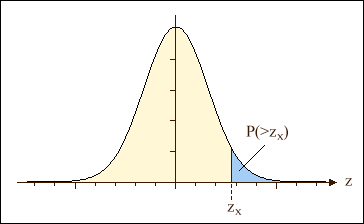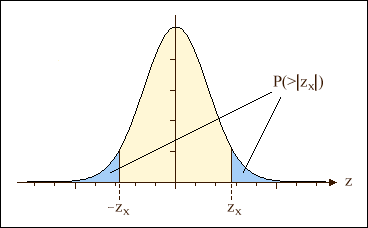| Fundamentals of Statistics contains material of various lectures and courses of H. Lohninger on statistics, data analysis and chemometrics......click here for more. |

|

Home  Statistical Tests Statistical Tests  Fundamendals Fundamendals  Level of Significance Level of Significance |
|||||
| See also: distributions, The Term "significant" | |||||
Level of SignificanceWhen observing a random process, there is always a certain probability that the results are above some threshold. The probability of this threshold being exceeded is called the level of significance α. Statisticians usually say "statistically significant at the 5% level", which means that there is 5% chance that the observed value occurs at random.(1) This term originates from the theory of statistical tests, where the random process is the test statistic. If the test statistic exceeds the limit zx (the critical threshold), the probability of making a type I error is α.
The shaded area of the distribution density above specifies the probability that the outcome z of an experiment exceeds the threshold value zx. Please note that in some cases, the interesting question may implicitly refer to two thresholds, as shown below:
In this case, the level of significance is the sum of the areas below -zx and above +zx.
|
|||||
Home  Statistical Tests Statistical Tests  Fundamendals Fundamendals  Level of Significance Level of Significance |
|||||



